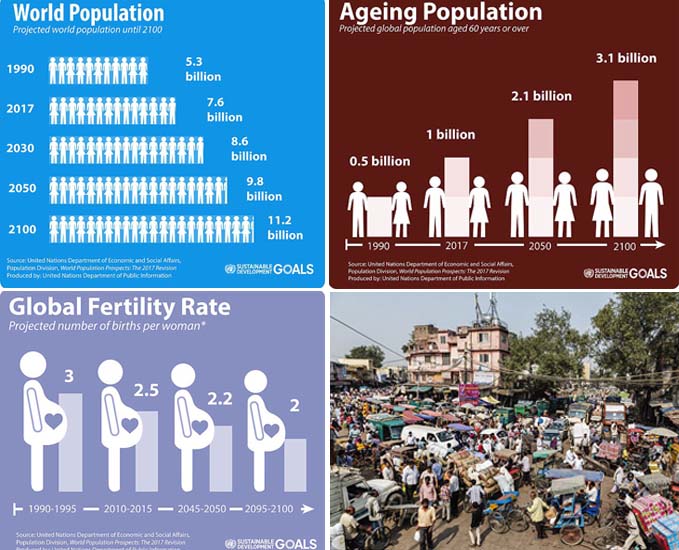2030, Penduduk Dunia Bertambah 1 Miliar, RI Tertinggi dengan 9 Negara
One Billion People will be Added to the World`s Population by 2030
Editor : Ismail Gani
Translator : Novita Cahyadi

POPULASI dunia akan bertambah satu miliar jiwa dalam 13 tahun ke depan dan hampir mencapai 10 miliar pada 2050, menurut prediksi Perserikatan Bangsa-Bangsa (PBB) dan Indonesia menjadi salah satu dari sembilan negara yang pertumbuhan penduduknya tertinggi di dunia setelah India, Nigeria, Congo, Pakistan, Ethiopia, Tanzania, dan Amerika Serikat.
Populasi dunia saat ini 7,6 miliar jiwa diperkirakan akan terjadi ledakan penduduk dalam satu dekade ke depan, yang sebagian besar didorong oleh tingkat kelahiran yang tinggi di Afrika, menurut laporan PBB terbaru.
India akan melampaui China sebagai negara terpadat di dunia, sementara Nigeria akan menyusul Amerika Serikat (AS) dan menjadi negara berpenduduk paling padat ketiga di dunia sebelum 2050, menurut sebuah hasil penelitian.
Sementara Eropa, yang saat ini memiliki tingkat kelahiran 1,6 anak per perempuan, diperkirakan akan mengalami penurunan populasi dalam beberapa dekade mendatang.
Laporan dari Departemen Kependudukan Divisi Sosial dan Ekonomi mengatakan sekitar 83 juta orang akan menambah jumlah penduduk dunia setiap tahunnya.
Tren kenaikan ini diperkirakan akan berlanjut bahkan dengan terus menurunnya tingkat kesuburan, yang menurun sejak tahun 1960an, menurut laporan tersebut.
John Wilmoth, direktur Divisi Kependudukan, mengatakan bahwa laporan tersebut mencakup informasi mengenai populasi 233 negara atau wilayah di dunia.
"Populasi di Afrika terkenal dengan pertumbuhannya yang cepat, dan diperkirakan bahwa setengah dari pertumbuhan populasi global antara sekarang dan 2050 akan terjadi di wilayah tersebut," katanya.
"Di sisi lain, diperkirakan bahwa populasi Eropa pada kenyataannya akan sedikit menurun dalam beberapa dekade mendatang."
Badan Kependudukan PBB memperkirakan bahwa mulai sekarang hingga 2050, setengah pertumbuhan populasi dunia akan terkonsentrasi di sembilan negara - India, Nigeria, Kongo, Pakistan, Ethiopia, Tanzania, Amerika Serikat, Uganda dan Indonesia.
Negara-negara tersebut terdaftar sesuai dengan 'kontribusi yang diperkirakan terhadap total pertumbuhan', kata laporan tersebut.
Pada periode yang sama, ditambahkan, populasi 26 negara Afrika diperkirakan menjadi dua kali lipat.
Nigeria, yang saat ini merupakan negara dengan penduduk terbanyak ketujuh di dunia, populasinya tumbuh paling cepat dari 10 negara terpadat di seluruh dunia, dan laporan tersebut memproyeksikan akan melampaui AS sesaat sebelum pertengahan abad.
Proyeksi baru juga memperkirakan bahwa China, yang saat ini memiliki 1,4 miliar penduduk, akan diganti sebagai negara berpenduduk paling padat di dunia sekitar 2024 oleh India, yang kini dihuni 1,3 miliar jiwa.
Laporan tersebut, berjudul 'Prospek Populasi Dunia: Revisi 2017,' menyatakan kesuburan menurun di hampir semua wilayah dalam beberapa tahun terakhir.
Antara 2010 dan 2015, Wilmoth mengatakan, 'wanita dunia memiliki 2 1/2 kelahiran per wanita sepanjang masa - tapi jumlah ini sangat bervariasi di seluruh dunia.'
'Eropa memiliki tingkat kesuburan terendah, diperkirakan 1,6 kelahiran per wanita pada periode terbaru, sementara Afrika memiliki kesuburan tertinggi, dengan sekitar 4,7 kelahiran per wanita,' katanya.
Laporan tersebut mengatakan tingkat kelahiran di 47 negara terbelakang relatif tinggi, dengan pertumbuhan penduduk sekitar 2,4 persen per tahun.
Sementara peningkatan ini diperkirakan akan melambat secara signifikan dalam beberapa dekade mendatang, PBB mengatakan bahwa populasi gabungan dari 47 negara diproyeksikan meningkat sebesar 33 persen dari sekitar 1 miliar sekarang menjadi 1,9 miliar pada 2050.
Semakin banyak negara sekarang memiliki tingkat kesuburan di bawah tingkat sekitar 2,1 kelahiran per wanita yang dibutuhkan untuk menggantikan generasi sekarang, kata laporan tersebut.
Selama periode 2010-2015, kesuburan di bawah tingkat penggantian di 83 negara yang terdiri dari 46 persen populasi dunia, katanya.
10 negara terpadat dengan tingkat kesuburan rendah adalah China, Amerika Serikat, Brasil, Rusia, Jepang, Vietnam, Jerman, Iran, Thailand dan Inggris, kata laporan tersebut.
Selain melambatnya pertumbuhan penduduk, tingkat kesuburan yang rendah menyebabkan populasi yang lebih tua, laporan tersebut mencatat. Diperkirakan jumlah orang berusia 60 atau lebih di atas akan meningkat dua kali lipat dari 962 juta menjadi 2,1 miliar pada 2050 dan lebih dari tiga kali lipat menjadi 3,1 miliar pada 2100.
Seperempat populasi Eropa sudah berusia 60 atau lebih, dan pangsa tersebut diproyeksikan mencapai 35 persen pada 2050 kemudian tetap berada di sekitar level itu selama sisa abad ini, kata laporan tersebut seperti dilansir MailOnline.
THE WORLD'S population will grow by a billion people in the next 13 years and will be almost 10billion by the time we reach 2050, the United Nations predicts.
The current population of 7.6billion is expected to balloon in the coming decade, driven largely by high birth rates in Africa, according to a new UN report.
India will surpass China as the most crowded inside the next seven years, while Nigeria will overtake the United States and become the world's third most populous country shortly before 2050, research suggests.
Meanwhile Europe, which currently has a birth rate of 1.6 children per woman, is set to see a decline in population in the coming decades.
The report by the Department of Economic and Social Affairs' Population Division said roughly 83 million people are added to the world's population every year.
The upward trend is expected to continue even with a continuing decline in fertility rates, which have fallen steadily since the 1960s, the authors wrote.
John Wilmoth, director of the Population Division, said that the report includes information on the populations of 233 countries or areas of the world.
'The population in Africa is notable for its rapid rate of growth, and it is anticipated that over half of global population growth between now and 2050 will take place in that region,' he said.
'At the other extreme, it is expected that the population of Europe will, in fact, decline somewhat in the coming decades.'
The U.N. agency forecasts that from now through 2050 half the world's population growth will be concentrated in just nine countries - India, Nigeria, Congo, Pakistan, Ethiopia, Tanzania, United States, Uganda and Indonesia.
Those nations are listed in the order of their 'expected contribution to total growth,' the report said.
During the same period, it added, the populations of 26 African countries are expected to at least double.
Nigeria, currently the world's seventh largest country, has the fastest growing population of the 10 most populous countries worldwide, and the report projects it will surpass the U.S. shortly before mid-century.
The new projections also forecast that China, which currently has 1.4 billion inhabitants, will be replaced as the world's most populous country around 2024 by India, which now has 1.3 billion inhabitants.
The report, titled 'The World Population Prospects: The 2017 Revision,' said fertility has been declining in nearly all regions in recent years.
Between 2010 and 2015, Wilmoth said, 'the world's women had 2 1/2 births per woman over a lifetime - but this number varies widely around the world.'
'Europe has the lowest fertility level, estimated at 1.6 births per woman in the most recent period, while Africa has the highest fertility, with around 4.7 births per woman,' he said.
The report said birth rates in the 47 least developed countries remain relatively high, with population growth around 2.4 percent a year.
While this rate is expected to slow significantly in the coming decades, the U.N. said the combined population of the 47 countries is projected to increase by 33 percent from roughly 1 billion now to 1.9 billion in 2050.
More and more countries now have fertility rates below the level of roughly 2.1 births per woman needed to replace the current generation, the report said.
During the 2010-2015 period, fertility was below the replacement level in 83 countries comprising 46 percent of the world's population, it said.
The 10 most populous countries with low fertility levels are China, United States, Brazil, Russia, Japan, Vietnam, Germany, Iran, Thailand and United Kingdom, the report said.
In addition to slowing population growth, low fertility levels lead to an older population, the report noted. It forecasts that the number of people aged 60 or above will more than double from the current 962 million to 2.1 billion in 2050 and more than triple to 3.1 billion in 2100.
A quarter of Europe's population is already aged 60 or over, and that share is projected to reach 35 percent in 2050 then remain around that level for the rest of the century, the report said.















